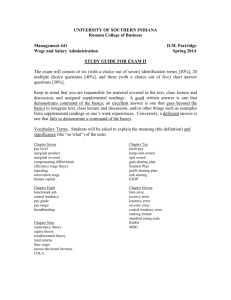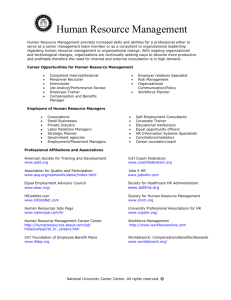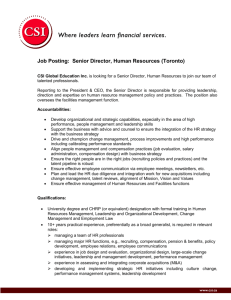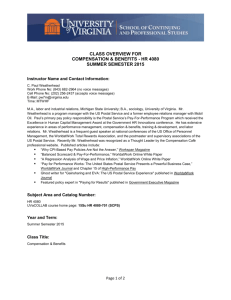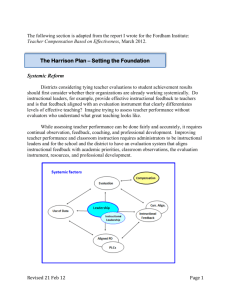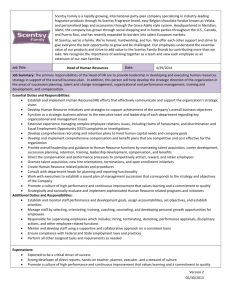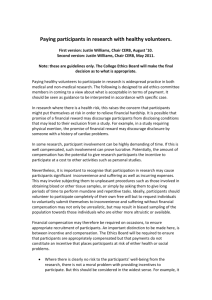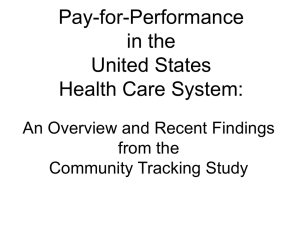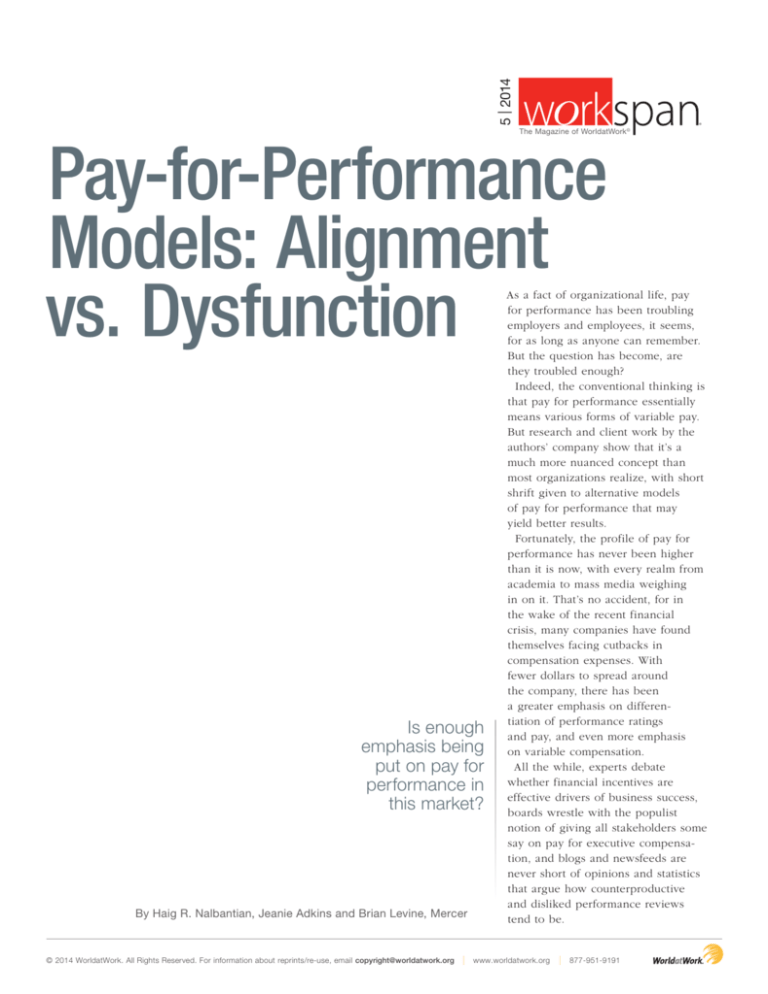
5 | 2014
The Magazine of WorldatWork©
Pay-for-Performance
Models: Alignment
vs. Dysfunction
Is enough
emphasis being
put on pay for
performance in
this market?
By Haig R. Nalbantian, Jeanie Adkins and Brian Levine, Mercer
© 2014 WorldatWork. All Rights Reserved. For information about reprints/re-use, email copyright@worldatwork.org
®
As a fact of organizational life, pay
for performance has been troubling
employers and employees, it seems,
for as long as anyone can remember.
But the question has become, are
they troubled enough?
Indeed, the conventional thinking is
that pay for performance essentially
means various forms of variable pay.
But research and client work by the
authors’ company show that it’s a
much more nuanced concept than
most organizations realize, with short
shrift given to alternative models
of pay for performance that may
yield better results.
Fortunately, the profile of pay for
performance has never been higher
than it is now, with every realm from
academia to mass media weighing
in on it. That’s no accident, for in
the wake of the recent financial
crisis, many companies have found
themselves facing cutbacks in
compensation expenses. With
fewer dollars to spread around
the company, there has been
a greater emphasis on differentiation of performance ratings
and pay, and even more emphasis
on variable compensation.
All the while, experts debate
whether financial incentives are
effective drivers of business success,
boards wrestle with the populist
notion of giving all stakeholders some
say on pay for executive compensation, and blogs and newsfeeds are
never short of opinions and statistics
that argue how counterproductive
and disliked performance reviews
tend to be.
| www.worldatwork.org
| 877-951-9191
But most organizations are not satisfied
with their pay-for-performance programs,
and there’s a general sense of
dysfunction.
In his 2009 book, “Drive: The
Surprising Truth About What Motivates Us,” Daniel Pink argues against
old models of employee motivation
driven by rewards and fear, and
focused on money, as opposed to
intrinsic motivation, such as mastery
of work and a sense of purpose.
And as if to underscore just how
hot the issue has become, a recent
PowerPoint presentation by top
management of Netflix went viral,
with more than 5 million views on
the Internet, according to a Harvard
Business Review story. The deck
detailed the company’s unconventional talent management and
performance strategies, which include
top-of-market pay, a resounding
emphasis on employee freedom, and
the abolition of formal vacation and
performance review policies.
Continuing Struggle
Simply, organizations continue to
struggle with pay for performance,
and it’s not getting any easier. If
anything, it’s more complicated, given
an uncertain global economy that has
meant everything from reduced payincrease budgets and incentive pools
to increased shareholder activism,
along with emerging government
regulations. That so many of the
performance measures used in typical
variable pay plans are driven by
systematic market and industry fluctuations over which employees have
little control, rather than by actual
worker performance, further complicates the design of effective incentive
compensation.
While human resources and total
rewards leaders have always sought
best practices in pay for performance,
the most prevalent approach has
been and continues to be the variable
34 | workspan may 2014
pay model, relying on increasingly
differentiated combinations of year-toyear base pay increases and incentive
payouts, all strictly aligned to individual performance for variable pay
— in addition to other measures.
But most organizations are not satisfied with their pay-for-performance
programs, and there’s a general sense
of dysfunction. Results of the “2013
Pay for Performance Survey” by the
authors’ company shows evidence
of such. The survey queried 570 U.S.
and Canadian organizations.
Arguably, the prevailing variable
pay model — reported by more
than 85 percent of participating
organizations as the reward model
most closely linked to performance — reflects an overused and
unnecessarily narrow view of pay
for performance, especially because
there are multiple models that can
vary the mechanism through which
higher financial rewards are made to
better performers. The key to success
is aligning the right model to each
organizational circumstance.
Clearly, organizations are looking
for better alignment. The 2013 survey
results showed that 55 percent of
participants focus “to a great extent”
on pay for performance for executive, managerial and sales employees,
while all but 5 percent are focusing
on it “to some extent.” But, more
telling, 63 percent of them are
working to increase differentiation of
pay based on performance — mainly
through guidelines for ratings distribution and next-level manager review
— while only 2 percent are working
to reduce that differentiation.
Yet nearly half of the organizations
surveyed believe that pay-for-performance programs “need work.” Survey
respondents embrace the concept
of pay for performance, but not
many said they have got the concept
working right in their organizations.
Multiple Models
Attracting and retaining the right
talent top the list of priority outcomes
expected of pay-for-performance
programs, followed closely by “motivating employees to focus on the
right things and perform at higher
levels.” To do so, organizations must
optimize their rewards programs —
and seriously consider whether the
prevalent variable pay model, with its
emphasis on pay differentiation and
links of payouts to contemporaneous
performance, is the right one.
Too many organizations have lost
sight of the fact that there is more
than one way to pay for performance. Following are three other
pay-for-performance models that organizations should consider deploying
as alternatives to or in combination
with traditional variable pay models
(for the enterprise or for different
employee segments):
❙❙ In a promotion-focused or “tournament model,” pay varies significantly
from one career level to the next,
with less emphasis on differentiation based on performance
among employees in the same
level. In this model, competition
for advancement, rather than the
size of the base pay increase or
annual incentive, is what motivates
employees to perform well. The best
performers earn more via promotions based on relative performance
evaluation. About 14 percent of
those in the 2013 survey reported
using this type of model.
❙❙ In a membership or “efficiency
wage model,” overall pay (and
benefit) levels are targeted above
the market median and employees
must perform to high standards to
stay on with the organization. In
this model, the desire to keep a
high-value position is what delivers
incentives to perform well. Again,
about 14 percent of those in the
2013 survey said they use this model
to attract and retain high-performing
talent and motivate performance.
❙❙ In a service or “bonding model,”
a trajectory of planned increases
shifts pay from early to later in the
career, once performance is credibly
demonstrated. This model also locks
in employees over the long haul,
preserving firm-specific knowledge
key to productivity while enforcing
performance minimums to stay with
the organization. Only 7 percent of
those in the 2013 survey reported
using this type of model.
As observed, about half of the
surveyed organizations indicated their
pay-for-performance programs need
improvement; one-third of them were
anticipating or planning revisions to
their programs.
Misalignment is a likely reason for
this, because many of those relying
on traditional incentive compensation are more likely to cite their
performance measurements as “noisy”
or influenced by other factors that
make actual performance levels
difficult to interpret. They may want
to consider alternatives that are
less dependent on the precision of
absolute performance measures and
require less frequent monitoring —
for example, the tournament model
that relies solely on rankings, or a
membership model that stipulates
a performance threshold.
While conclusions are limited
because of the self-reported nature
of the data, the survey supports that
using the right model in the right
context can enhance effectiveness
of pay-for-performance programs.
Respondents were classified as
To read a book about this topic,
log on to www.worldatwork.org/
workspan.
using a particular model when they
said they “strongly agreed” that the
approach was a primary mechanism
for managing pay for performance.
Those respondents focused on the
membership model — high pay relative to market — report the highest
levels of effectiveness. The model is
most often used by employers who
say they are trying to balance “build”
and “buy” talent strategies — that is,
to build or develop from within, or to
buy talent on the open market — to
support the attraction and retention
of high performers.
Surveyed companies using the
tournament or promotion-based
model judged their plans as more
effective than companies relying on
more traditional incentive compensation models. The tournament model
is associated with build-from-within
talent cultures, but, given the model’s
reliance on relative ranking (and,
therefore, competition), it is less
likely to be appropriate for employers
reporting a high need for collaboration in their organizations. While
more research is needed on this
point, the survey supports the point
that organizations fare better in
managing pay for performance when
their models are aligned with their
company culture and attraction/retention/engagement strategies, as well as
with their measurement approaches.
against the need for consistency
in complex, global organizations,
especially those with high rates of
employee mobility.
Indeed, workforce capability and
motivation are two areas that companies can focus on — not only to drive
performance but to solve the pay-forperformance challenges raised by an
all-too-prevalent variable pay model
and a lack of clarity, or courage,
when it comes to other models and
segmentation strategies that may
be better aligned to the organization. “Big data” analytics for human
resources can be leveraged to track
the effectiveness of these approaches,
and ensure that they drive retention
and performance.
Ultimately, companies must invest
more time in identifying talent
needs and strategies, critical talent
and factors that influence employee
behaviors. It’s a matter of being open
to alternative models, assessing fit
to context, monitoring effectiveness
and optimizing accordingly. Despite
all the noise and negativism that
surround pay for performance in
today’s wired world, it’s a riddle that
each organization must solve in its
own way. Haig R. Nalbantian is a senior partner and
co-leader/founder of Mercer’s Workforce
Sciences Institute in New York. He can be
reached at haig.nalbantian@mercer.com.
Model Segmentation
Slightly more than one-third
(36 percent) of survey participants
reported using multiple pay-forperformance models, but it’s not
clear to what extent this reflects
their use of a combination of models
versus using different models for
different employee segments, such as
business units, job families or multinational locations.
The complex question of how
different models may be used
optimally for different workforce
segments is worthy of careful, expert
exploration. And while such segmentation only makes sense, it’s vital to
balance any segmentation strategy
Jeanie Adkins is a partner at Mercer
in Louisville, Ky. She can be reached
at jeanie.adkins@mercer.com.
Brian Levine is a partner and workforce
analytics and planning leader at Mercer
in New York. He can be reached
at brian.levine@mercer.com.
resources plus
For more information, books and
education related to this topic, log
on to www.worldatwork.org and
use any or all of these keywords:
❙❙ Pay for performance + model
❙❙ Pay for performance
❙❙ Variable pay.
may 2014 workspan | 35

